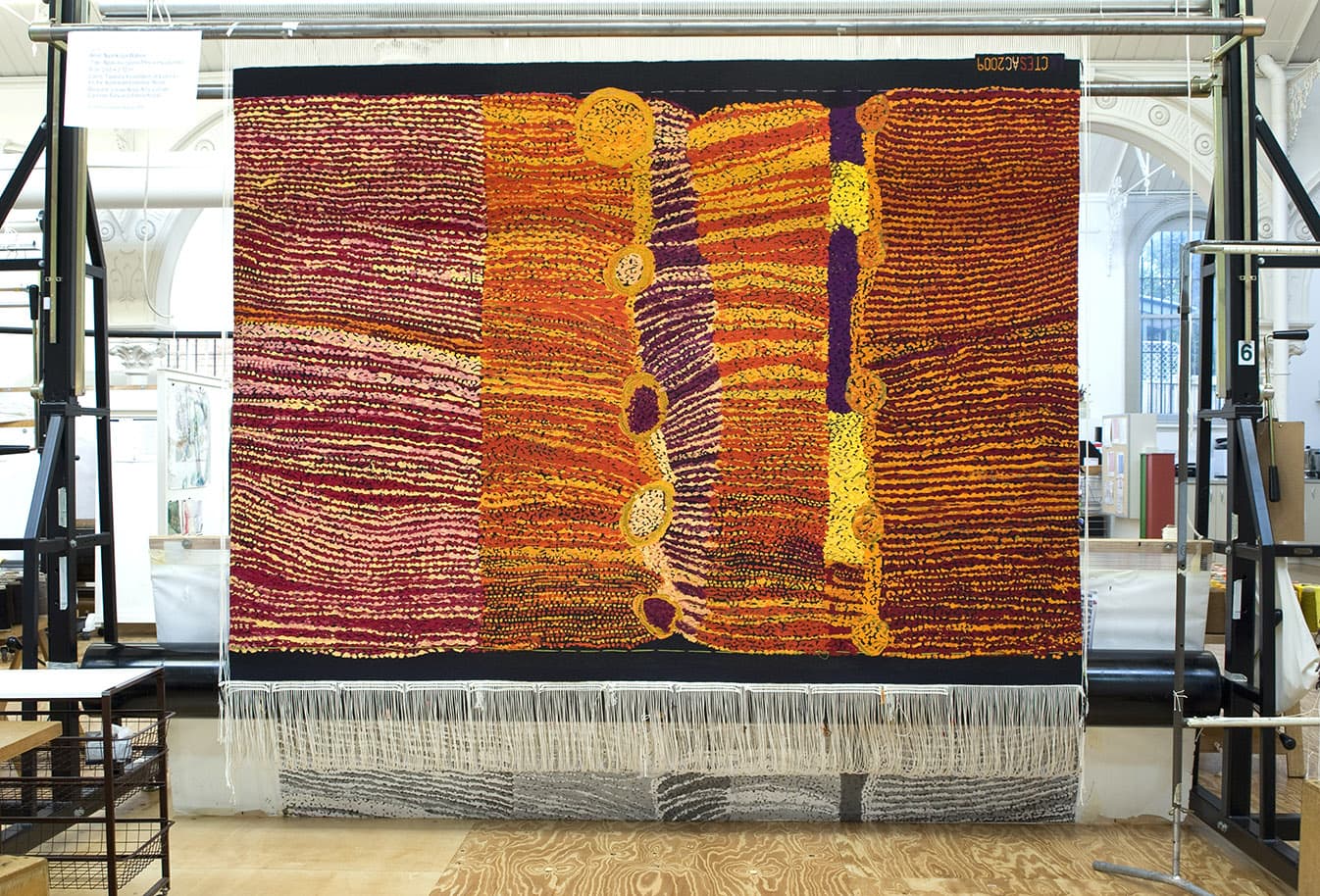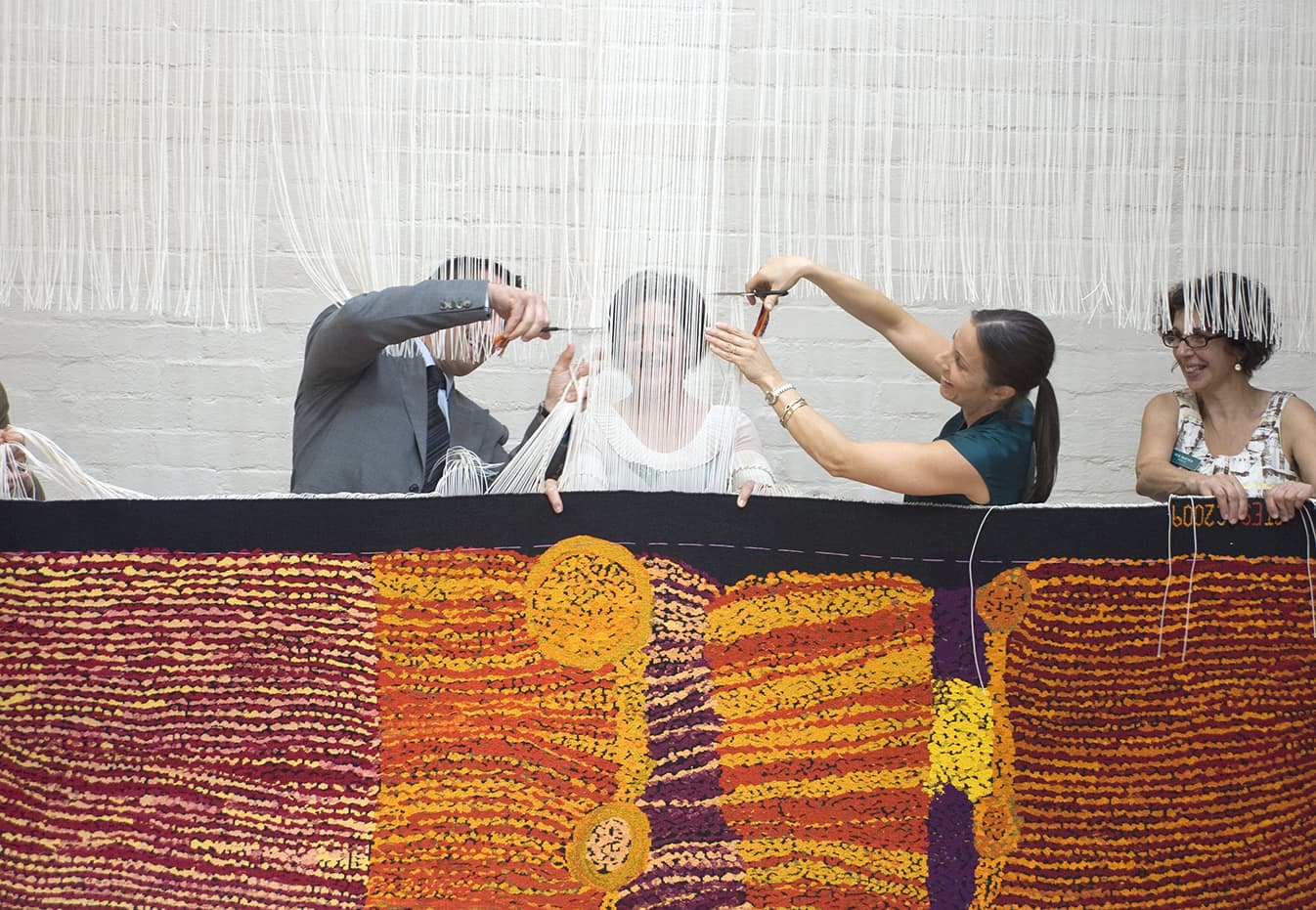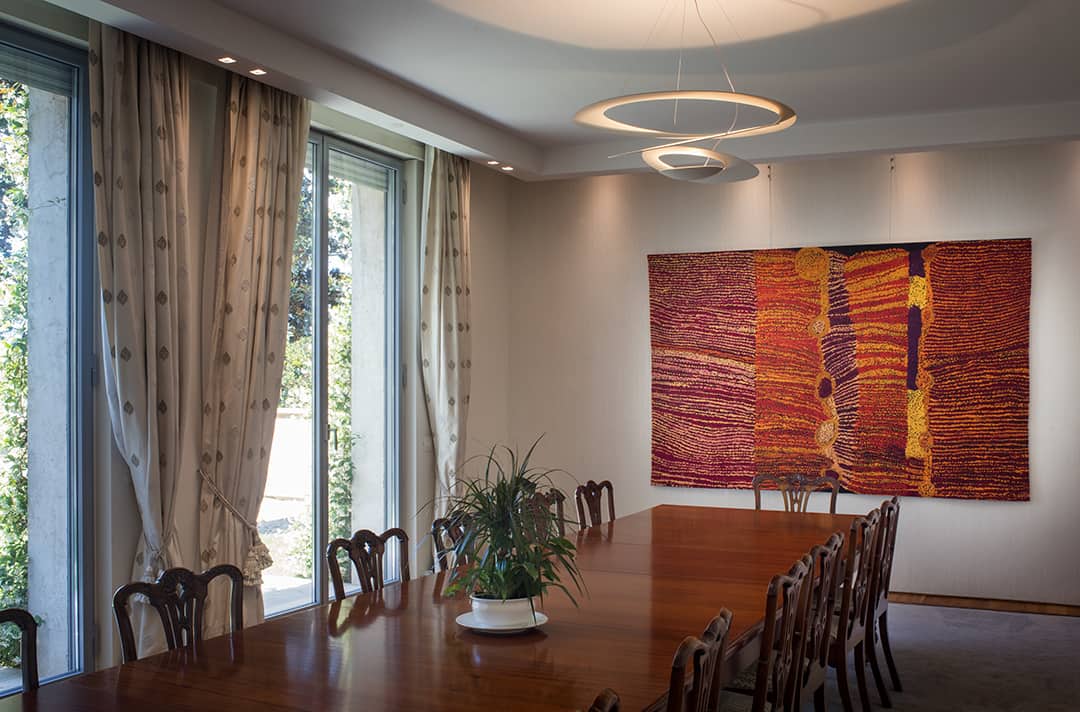



In 2010 Ngayuku Ngura (This is my country), a painting designed by senior Pitjantatjara artist and elder Nyankulya Watson, was translated into tapestry as the latest addition to the Embassy Collection series, commissioned by the Tapestry Foundation of Australia.
Watson was born around 1938 at a rock hole near Mt Aloysius, in remote Western Australia, close to the South Australian border. As a teenager she lived at Anumarapiti, now an outstation of Irrunytju, later moving to Ernabella in northern South Australia (then a Presbyterian mission). Watson was a founding member of Irrunytiju Arts and she now lives in the Nyapari and Kalka communities in South Australia.
Speaking of the painting, Watson notes that there “are many rock holes close to the place I was born. I would travel to all these places with my parents. Ngayuku ninti pulka (I know all this country). Aloysius is the main rock hole. The other rock holes in this painting are Pukara, Anumarapiti, Palki, Punuwara, Wangutiti, Atanga, Yaliri, Plalkarli and Wirkuratja. This country is in Western Australia. The lines are the travelling tracks in the sand from all the people walking to the waterholes and places where the bush foods grow."
The strong red and magenta tones, contrasting with the black of the background, create a tension which is disrupted by the change in scale and media, from painting to tapestry. To help balance the black background with the reds, the weavers used a blue-black and a grey-black, allowing the blacks to recede slightly, and the reds to eloquently emerge.
Ngayuku Ngura (This is my country) was commissioned by the Tapestry Foundation of Australia, and funded by private donations.
Watson now paints for Tjunga Palya and Ninuku Artists in South Australia.
Having been raised within the Pupunya Tula art movement, it wasn’t until 1998 that Elizabeth Marks Nakamarra began painting in her own right. Nakamarra’s painting Creek bed was translated into tapestry by ATW weavers in 2009, as the fifth addition to the ATW’s Embassy Collection.
Growing up Nakamarra assisted her stepfather Turkey Tolson Tjupurrula and uncle Johnny Warangkula Tjupurrula, with their paintings, and continued to assist her late husband Mick Namarari Tjapaltjarri with his painting until his death in 1998. Nakamarra studied for three years at the Bachelor College in Alice Springs and served as a council member in Kintore for two years. After the death of her husband, Nakamarra began painting her father’s stories from the area of Kalipinypa, located approximately 400 km west of Alice Springs and north of Sandy Blight Junction.
Nakamarra’s paintings revolve around the subject of the Dream Time—the time before man walked the earth, when a huge storm caused lightning to flash and the water torrent formed the landscape creating rock holes, soaks and creeks. Her paintings depict this wellspring of life; the water sources, throughout the diverse terrain of the western desert, both heavenly and subterranean.
The ATW Embassy Collection consists of tapestries designed by Indigenous Australian artists, produced specifically to be loaned to Australian Embassies around the world. Creek bed is currently on loan to the Australian Embassy in Paris, designed by Harry Seidler and opened in 1978.
The original painting has a subdued understated palette that belies the complex painterly nature of the work. The weavers had to make many complex decisions regarding the amount of painterly information to include in the interpretation and the most economical ways to recreate Nakamarra’s limited but layered and complex colour scheme. When interpreting the artwork, the weavers found that the linear brush strokes required much thought, as they simultaneously describe the forms within the painting while also sitting forward or back to generate a sense of space and movement within the work. Each line is made up of distinct brush strokes, approximately 2 cm long, which have distinct borders around the edges and a slight translucency in the centre. Elizabeth’s lines have been painted onto a black background.
The weavers have simplified Nakamarra’s brush strokes in their interpretation, and have limited their palette to 3 or 4 tones in each bobbin for the four main colours in the tapestry- a close equal to the ‘real’ colour, a brighter tone and a colour to represent the background, with another tone or colour as needed. A blue instead of a black has been chosen to express the background and will run through all the bobbins as well as being used as a pure colour that will peep through the edges of some of the forms, acting as highlights—a detail the weavers have included from the painting. The weavers chose this colour as it blends more harmoniously with the other tones in their interpretation and works well when included in the schema of the four main colour mixes.
Creek bed was commissioned by the Tapestry Foundation of Australia, and funded by private donations.
Trevor Nickolls was the first Indigenous artist formally trained at an Australian art institute, gaining a Diploma of Fine Art at the South Australia School of Fine Art in 1972.
His art is both autobiographical and universal, drawing freely from both European and Aboriginal art traditions, although he had no real contact with Aboriginal art until the late 1970s.
The painting on which the tapestry is based was painted on an expedition to Warmun, Western Australia in 2002, to visit Rover Thomas' country, Turkey Creek, after his death in 1998.
To translate the texture and form of the painting, the weavers used exaggerated stepped lines and chunky forms to capture this vigorous, structural feel. They also incorporated a blue-grey tone and a green-grey tone into the large areas of black to give the sky a sense of movement and depth.
This tapestry was commissioned by the Tapestry Foundation of Australia and supported by the Norman, Mavis & Graeme Waters Charitable Trust. The tapestry was produced for the Embassy Collection and is currently on loan to the Australian Embassy in Washington DC.
Nickoll’s work is represented in an extensive array of prestigious regional and metropolitan public gallery collections, and he was chosen to represent Australia in the 1990 Venice Biennale alongside Rover Thomas.
The design for Untitled (detail from Kiwirrkurra Women’s Painting) is a detail taken from a painting created by a group of seventeen women artists from the Kiwirrkurra community in Western Australia in 1999.
The detail selected for interpretation was painted by Nanyuma Napangati, who was assisted by Polly Brown Nangala. Napangati is of the Pintupi language group. Born in 1944, she is the sister of Charlie Tjapangati and is also related to Pinta Pinta Tjanpanangka and Kanya Tjapangati. She is a senior artist who has exhibited widely in Australia and overseas.
As with many indigenous works, the piece depicts locations, events, and relates a narrative depicting “designs associated with the rockhole and soakage water site of Marrapinti, west of the Kiwirrkurra community. A large group of women camped at this site.....While at the site the women made nose bones...which are worn through a hole made in the nose web..... The women later continued their travels......as they travelled they gathered edible berries known as ‘kamurarrpa' or bush raisin, which they ground into a paste to form a type of damper. [1]
The Western Desert (Pintupi/ Naami/ Ngaatjatjarra) artists traditionally occupied the Western Desert region and now live mostly at Kintore and Kiwirrkurra, close to the Northern Territory and West Australian borders. The painting that the design is taken from was produced for an art auction to raise money for dialysis treatment for those affected by kidney disease in communities in the Western Desert.
The original painting is very large, and belongs to private owners in Sydney. As the Workshop was not able to borrow the original painting, project leader Cheryl Thornton travelled to Sydney to see the work. Careful colour matching with our wool colour samples and pantone colour cards was undertaken and comprehensive photographs were taken to use as a reference for the weavers. The red / brown ground of the painting is an important aspect of the tapestry. The palette is limited with subtle accidental variations within each colour. Unlike some indigenous artists, Napangati's marks in the form of dots are not clear separate dots but are linked by dragging her brush from one dot to the next. These marks in themselves were a challenge for the weavers.
This tapestry is the fourth tapestry produced for the Embassy Collection and is currently on loan to the Australian High Commission in the UK, London. It was previously on display at the Australian High Commission in New Delhi.
Untitled (detail from Kiwirrkua Women’s Painting) was made possible by the support of the Department of Foreign Affairs and Trade and corporate and private donations through the Tapestry Foundation of Australia.
Nanyuma Napangati is represented by the Papunya Tula Artists.
Daisy Andrews comes from the remote Aboriginal community at Fitzroy Crossing in the Kimberley region of Western Australia. She was born at Cherrabun Station and belongs to the Walmajarri people. In 2004 the ATW translated her painting, Lumpu Lumpu country, into a tapestry.
The country of Lumpu Lumpu is Andrew’s ancestral terrain, but her family were already displaced when she was born. Stories about the land were narrated to Andrews by her parents and grandparents, but she only visited the area later in life. Her family, driven out by dispossession, were too traumatised to return. Andrew's paintings, drawings and prints of Lumpu Lumpu are made as memorials to her homeland.
The tapestry Lumpu Lumpu country captures the drama of the landscape with its cliffs and valleys, wildflowers and blazing red earth. The carpet of purple flowers finds a visual echo in the lavender coloured sky, and the whole image is suffused with sentiment. Andrew states “when I draw my picture I am seeing that good country in my head, looking at those sandhills, flowers, everything was very good. I think hard when I look at my country. I think how I have to paint it. I look hard, it makes me sad too, it is beautiful, good country, but it makes me sad to think about all of the old people who were living there.” [1]
This tapestry was the first tapestry produced for the Embassy Tapestry Collection and is currently on loan to The Australian Embassy in Tokyo. Lumpu Lumpu country, was commissioned by the Tapestry Foundation through the support of a number of private donors.
Since 1991 Andrews was an active member of the Mangkaja Arts Centre. Andrew’s work has been exhibited and housed widely in national and international collections.
The ATW was saddened to hear of Daisy’s passing in 2015 and hopes that her tapestry can exist as a legacy to her life story.
[1] Daisy Andrews, quoted in the Victorian Tapestry Workshop Newsletter, Vol 1, Issue 16, October 2004.
To celebrate the Melbourne Cricket Ground’s 150th anniversary, the Melbourne Cricket Club tapestry, designed by Robert Ingpen AM was woven by the ATW in 2002.
The monumental tapestry, measuring 2.00 x 7.00m, depicts key members of the Melbourne Cricket Club (MCC). Placed in chronological order, the figures depicted range from the MCC’s first president, Frederick Powlett, to champion Australian batsman-keeper Adam Gilchrist and Socceroo Kevin Muscat, who kicked Australia’s only goal in its 1-0 victory over Uruguay in a 2001 World Cup qualifying match.
Included are some of the greats of football and cricket, memorable sporting events such as the 1956 Olympic Games and Austral Wheel Races and other notable occasions like royal and papal tours, Billy Graham’s Crusade and the performance by the Three Tenors.
Ingpen painted the figures individually and then painted a broader yellow / orange canvas, allowing the weavers to position the figures as the tapestry developed on the loom.
The tapestry hangs proudly outside the Long Room at the MCG, where members and visitors can admire and identify those who have made a significant contribution to what the MCG is today.
Robert Ingpen is represented by Melaleuca Gallery in Victoria.